A Return to the Lands of Sword & Planet Fiction
While looking for something to include in the Substackosphere section of this week’s Weekly Geekly Rundown, I came across
’s latest discussing Sword & Planet fiction. It’s a fun entry discussing a topic that long time Geekerati readers know is near and dear to my heart (see the multiple Sword & Planet/Planetary Romance links at the end of this essay).Ethan mentions two of the central works of Sword & Planet fiction in his essay, Edgar Rice Burroughs’ tales of John Carter and C.L. Moore’s tales of Eric John Stark, and connects them with Denis Villeneuve’s Dune. While some might balk at speculation that Dune is Planetary Romance because of its strong association with Space Opera (an association Ethan notes), I think a good case can be made for the first novel to be included in the genre. While the set up is different than John Carter, Carson Napier, or Eric John Stark, the overarching narrative meshes.
As a depiction of The Great Game, with its Great Houses and “Trade Company Rule,” the stakes are similar to those of A Princess of Mars and the Atmosphere Factory or The Mood Maid with it’s resistance to the Kalkars. In both cases, the opposition is to Russians (or their space proxy in Moon Maid). Who constitutes the English and Russian sides in Dune is not easy to discern, as Dune is only partly inspired by The Great Game, but the Harkonnen might be a good guess from a certain perspective. Though the fact they Harkonnen is a Finnish name might suggest against it. Then again, the fact that Emperor Napoleon attempted to side with the Russians in an invasion of India to control the Spice and Land Tax argues for it, until the assassination of Paul I of Russia (oops we’re back to Atreides being Russian) ended the scheme.
All of this is to say that the politics of The Great Game make for a morally complex narrative that is fertile ground for Sword & Planet style action. More than that, it had long lasting geopolitical effects and a book about the period (Rudyard Kipling’s Kim) served as the inspiration for the naming of Kim Philby. It should also be stated that the focus on hand to hand combat in the novel (the movies really have too much Lazgun action) adds weight to that comparison. Oh, and if you’re a fan of Marvel’s Killraven series, I definitely recommend The Moon Maid.
In addition to sparking more thoughts on Dune and its connection to an often ignored part of world history, Ethan’s essay reminded me that I needed to continue my own investigation of C.L. Moore’s anti-hero Northwest Smith.
C.L. Moore Once Again Provides an Interesting Twist on a Classic Trope
C.L. Moore’s third Northwest Smith story “Scarlet Dream” was published in the May 1934 issue of Weird Tales, the same issue that featured Robert E. Howard’s “Queen of the Black Coast,” making it a very important issue for pulp fans in general. “Queen of the Black Coast” is an often adapted story of Conan the Barbarian, one that is alluded to in the most recent 12 issue story arc in Titan Comics new Conan Comic book written by
Moore's tales of the interplanetary rogue trader Northwest Smith are an interesting mash up of a variety of genre. While they contain elements of traditional Westerns, they also contain elements of Planetary Romance, and Weird Horror. Though the character has been referred to many times as one of the inspirations for Han Solo, the illustration from the publication of the tale in Weird Tales suggests a desire to connect the character with the Planetary Romance genre. Moore’s frequent use of mythology and fairy tale references in her stories only strengthens the connection to Planetary Romance.
In addition to being the third published story about Northwest Smith, “Scarlet Dream” is also the third story in Paizo's Northwest of Earth collection. While each of the prior two Smith stories had elements of horror, it is in this tale that we can really see C. L. Moore developing her voice as an author of the weird supernatural tale. Of the first three Smith tales this is the best of the bunch. Given the overall quality of the tales, that’s a high compliment indeed.
So what happens?
The shawl, "clung to his hands like a live thing, softer and lighter than Martian 'lamb's-wool.' He felt sure it was woven from the hair of some beast rather than from vegetable fiber, for the electric clinging of it sparked with life. And the crazy pattern dazzled him with its utter strangeness."
Plot Overview (Spoilers Abound for this 90 Year Old Story)
As with her prior Smith stories, there is little within the narrative itself that signifies that this is a science fiction story. Other than the fact that Smith eventually uses his magic wa... err ... "gun" against a foe, this story fits firmly within the narrative tropes of the classic "faerie" tale. Like Christina Rossetti's wonderfully frightening Goblin Market the tale demonstrates the consequences of tasting the "fruit" of Faerie. In a manner similar to Lord Dunsany's King of Elfland's Daughter, “Scarlet Dream” has time move at different rates in “the land of magic” than it does in the real world. Unlike either of those tales, morality offers no salvation for our hero. Northwest Smith is not saved due to his strong virtuous code.
"Scarlet Dream" begins with Northwest Smith wandering the streets of a vibrant bazaar where he purchases a shawl made of an unbelievably light textile and bearing a mysterious glyph. The shawl, "clung to his hands like a live thing, softer and lighter than Martian 'lamb's-wool.' He felt sure it was woven from the hair of some beast rather than from vegetable fiber, for the electric clinging of it sparked with life. And the crazy pattern dazzled him with its utter strangeness."
In describing the physical properties of the shawl, Moore provides foreshadowing to the events that are about to unfold as the tale progresses. This foreshadowing is masterfully done because it occurs in a description where one does not assume the author is providing a map to the structure of the tale.
Who would guess that the shawl clinging "to his hands like a live thing" hinted at darker things to come? Not darker things from the shawl itself, that would be obvious, but darker things that come as a result of the unnatural properties of another world. The use of strange patterns and objects of alien make would be used again by Moore in her section of Challenge from Beyond -- a shared universe tale she wrote in 1935 with H.P. Lovecraft, A. Merritt, Robert E. Howard, and Frank Belknap Long. Each of those authors adding their own characteristic touches to the story. In Moore's case, that touch is an artifact -- a shawl in "Scarlet Dream" and a crystal in "Challenge."
The market where Smith buys the shawl is in the city of Lakkmanda on Mars, but the description of the market is similar to one that might be given to the bazaar of Baghdad and one might wonder if the name Lakkmanda inspired a young Fritz Leiber to create the name Lankhmar.
It is not until Smith returns to his hotel room, a small cubicle of polished steel, that one gets any visual sense of the science fictional (sfnal). This insertion of steel walls doesn't detract from the story that isn't a "hard science" tale, it adds to the mystery and sense of wonder as the tale unfolds. Northwest Smith tales are patchwork quilts of multiple genres that are knitted together by Moore’s masterful prose.
Smith falls asleep covered in the shawl and is overtaken by a disturbing dream. He awakens, only to fall back asleep into another dream. It is in the second dream that Smith's consciousness is transported to a temple building surrounded by a fantastic land. Soon after his arrival he meets a young woman who is fleeing a horrible beast. She is covered in blood and frantic. Smith calms her and soon discovers that he is in an eerie bucolic paradise. The weather is pleasant and the lakeside landscape is beautiful. The temple building where he awakened is the only large man made structure. Though there are small structures to be found, there are no books, no worldly distractions, and as he soon learns...no food.
He is initially puzzled by the lack of food, but the beauty of the land -- and of the woman (whose name is never revealed) -- intrigues Smith and he follows the young woman to her house. The next day Smith finds himself overcome with hunger and asks the young woman to take him to the temple to acquire sustenance. When he arrives, he sees people kneeling before spigots docilely consuming the liquid being dispensed. He himself begins to partake when he realizes that the people, and now he himself, are feeding on blood! No mention is made of where the blood comes from, and Smith recoils in horror at the thought of feeding on blood. Yet...he has found it satisfying. As the days pass, he eventually partakes in a routine of idyllic days and nights with the young woman interrupted only by regular feedings at the temple. Smith has completely overcome any moral objections to the feeding, satisfied that it sustains him. This scene reminded me of a scene in the recent Willow television series on Disney+. That series also featured an otherworldly place with a temple and a pool of liquid to feed upon.
Throughout the story, there are references to a beast of some sort that was responsible for the murder of the young woman's sister -- a beast that eventually comes for everyone when their time has come. Smith is unworried, and the girl is fatalistically accepting of her mortality. Life in this world is idyllic, yet the routine of it eventually overcomes Smith. He needs adventure and discovery, not a dull routine in a beautiful setting. Unable to return home, he decides that he must journey within this realm to find adventure, but this is to be denied him. The planet has no food to sustain him, save for the temple's blood spigots, and Smith learns another terrifying fact. It seems that the entire planet, plants and all, are alive and feed on the blood of living things. If you stand too long in one place, the grass will drain you of your blood. You cannot sleep if you aren't on stone as the plants will eat you. This is a world where all the denizens are sustained by blood.
Smith is not shocked or terrified by the prospect, he is resigned to satisfy his sense of adventure. His spirit cannot be sentenced to a life of dull routine. It is his Fredrick Jackson Turnerian frontiersman spirit that saves him from a fate worse than death.
How? That's for you to find out when you read the story.
Thoughts After Reading
What is particularly interesting in this story is the way that Moore uses the traditional elements of the faerie story, that of entering a beautiful but dangerous world, while demonstrating how a non-moral actor would react to the environment.
What use has the adventurer for bucolic paradise?
Apparently, not much. It would be unfair to leave out the fact that the girl, like the sister in Goblin Market, sacrifices herself in order to save a beloved, but in Goblin Market the spirit of curiosity is the culprit and not the savior as it is for Smith. Also interesting was Smith's reaction to the feeding process in the world. He is initially revolted, as I imagine any one would be, but he quickly overcomes his moral rejection and feeds like everyone else. This is the moment where the audience, though not the character, get to feel a sense of cosmic horror. We look into the abyss with Smith, horrified, but he allows the abyss to look back into him and is largely unaffected. This is a disturbing thing to read. How does one react to a protagonist who so quickly, Smith does not resist eating for days nobly suffering before succumbing, to temptation?
Smith may never have discovered the name of the young woman, but the audience never discovers the origin of the blood the people feast upon. Is it the blood of those killed by the beast? Is it the blood of those killed by the planet? Is it the blood of the planet? If it is the blood of those killed by the beast, is some of it the young woman's sister's blood? Creepy...and wonderful.


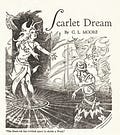



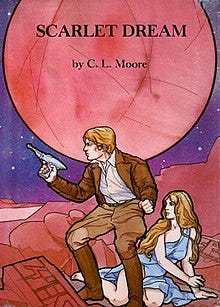
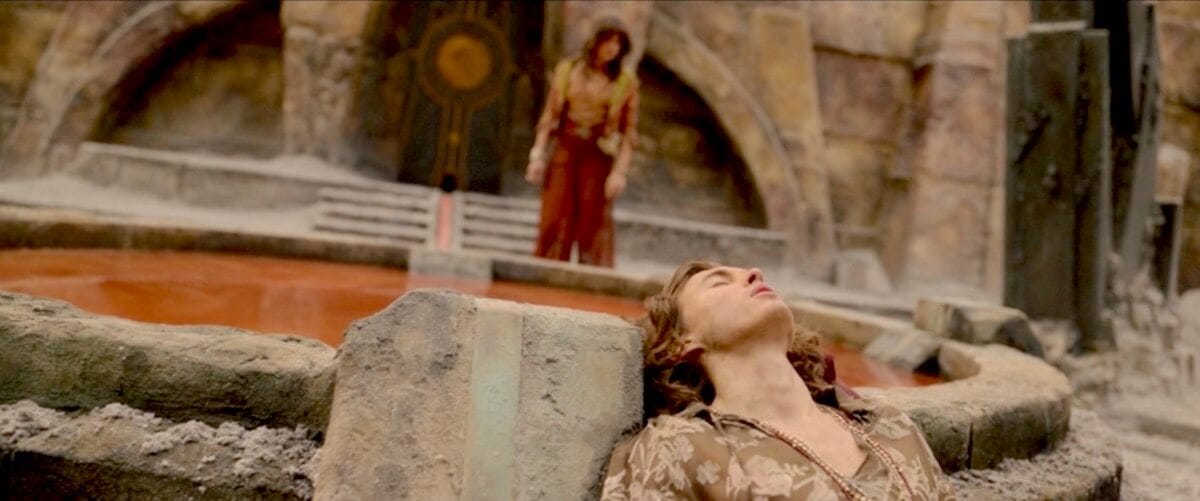
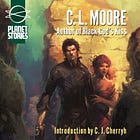
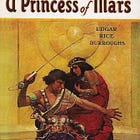
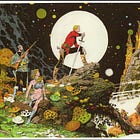
Thanks for including my post! I really thought it was amusing how in "The Challenge from Beyond" you can clearly see the switch between H.P. Lovecraft having the protagonist lose his sanity as he realizes his mind has been transported into the body of an insectile alien and the same protagonist going on a passionate killing spree once Robert E. Howard takes up the writing baton.
Great post and great recs! June seems like a fitting month to have things be Sword & Planet related for some reason.
Interesting topic, though I had completely forgotten that the Willow series had existed until now, so thank you for that.